Determining how often should you add compost to your vegetable garden is a wise question any grower should ask. Whether you grow vegetables inside or out, supplementing your veggies with a fertile, nutrient-dense layer of compost makes your plants produce better-tasting results.
Depending on your soil quality, add 3 to 6 inches of compost and mix it into the top 6 inches of your existing garden soil twice yearly. Annually, the best two times to spread compost are 4 to 6 weeks before your first spring planting and again in late fall, directly after your last harvest. Between these two seasonal times, evenly spread one inch over your growing area to provide extra nutrients for your heavy-feeding plants like asparagus, celery, corn, cucumbers, peppers, broccoli, and tomatoes.
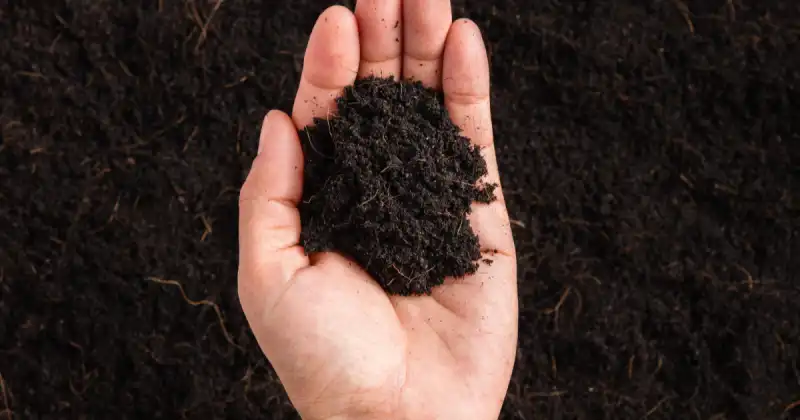
There’s no question that gardening is one of the most rewarding activities, and backyard composting is essential to sound practice and healthy plants.
In this article, we’ll help you discover everything you need to know about the importance of composting, when and why to apply this “black gold” during certain times of the year, and some additional tips to get your vegetables producing big-time!
Humble Highlights
- Save time by learning the 4 ultimate elements you must include within your compost pile so it can get off to the best start and work more efficiently.
- Discover the best times of year to add compost to your vegetable garden (and how much), no matter what kind of garden you have, so you can keep your soil fertile year-round!
- Discover how you can save money AND give your plants a healthier environment they’ll love by adding compost before planting so you can maintain a healthier and more productive garden.
What Is Compost
Compost is considered nature’s recycling process. It is a mixture of decomposed organic materials, including kitchen scraps and yard waste, that improve your garden’s soil quality by aerating and loosening compacted soil and adding organic matter that, in turn, feeds the beneficial soil microbes, like bacteria and fungi.
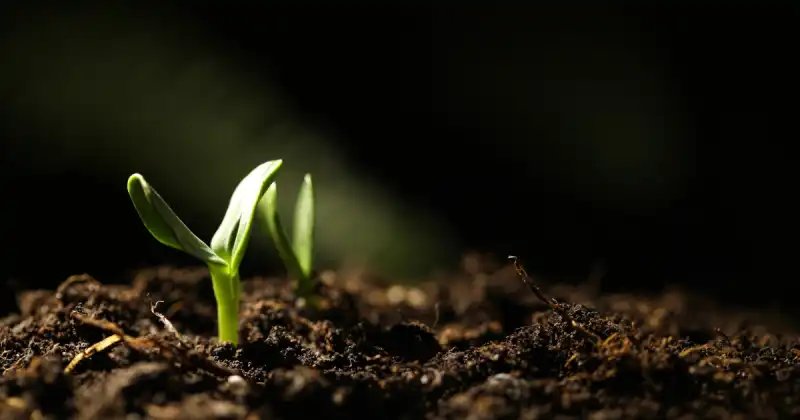
Whether you purchase store-bought varieties, like composted manure, or make your own at home, compost is the ultimate vegetable garden maintenance tool. Using compost means creating an environment where soil receives and retains air and water, protecting crops from disease and pests.
A humble gardener knows that making a homemade compost pile from kitchen scraps and yard debris helps reduce household waste. Further, they don’t guess what’s in their heap, they know. And by understanding the ingredients, they know what will ultimately find their way into the vegetable beds they care for.
An excellent homemade compost pile includes nitrogen and carbon waste products that “cook” or heat up and decompose over time. For this organic matter to break down correctly, your compost pile must have:
- An adequate and continuous airflow
- A damp environment
- Heat (the temperature of your pile goes up when it starts breaking down)
- Correct chemical balance (nitrogen-rich “greens” and carbon-rich “browns”)
Check Lowest Prices On Compost Tumblers Today
According to the book Year-Round Edible Gardening by Lena, Israelsson, the two primary ways of gathering your compost include garden and kitchen compost.
Garden compost is considered an open system where you deposit carbon-rich waste. This compost area works best outside, in a shady spot, and should be a reasonable distance from your home. Feel free to throw small branches, wood chips, leftover dirt, sawdust, and grass clippings into your pile to build your heap.

In contrast, kitchen compost, collected on your kitchen counter in a purposed bin or recyclable unit, is a closed system where kitchen waste is placed. Kitchen compost is typically high in greens (nitrogen) and lacks carbon (browns) found in sawdust, dried leaves, and cardboard. Fortunately, you can compensate by substituting shredded egg cartons and paper towels to help balance your ratio.
Once your kitchen composter is full, dump it into your outdoor garden compost or tumbler. For optimal results, take a garden fork and mix your compost heap at least once a week to provide adequate oxygen for all of the beneficial worms and microorganisms that are working hard on your behalf to break down your heap. 1
Check Lowest Prices On Garden Forks Today
Also, don’t toss any mature weeds you may have pulled from your garden or yard into your compost. Weed seeds may lie dormant if your pile doesn’t heat up sufficiently, potentially spelling bad news come spring. When you inadvertently carry these weed seeds from your compost into your garden, they may sprout anew.
How To Add Compost To A Vegetable Garden
Generally, add 3 to 6 inches of compost to the top 6 inches of soil by layering it on top or mixing it with a garden rake or hoe. If you have more complex or dense soil, consider adding 6 inches to allow your compost to amend your garden. Then, carefully spread the compost evenly throughout your growing space, ensuring it doesn’t become compacted. If you have a limited supply, add a generous handful into the planting holes of your plant starts or incorporate the compost in your seed-sowing rows.

Adding compost to your vegetable garden is one of the easiest and most practical ways to improve soil quality and provide needed nutrients to your plants throughout any growing season.
Although I advocate making homemade compost, if buying store-bought, always read the label and the accompanying ingredients. Compost must remain as natural as possible. If you’re growing organically, you’ll want to avoid adding something to your garden that contains harmful chemicals, which could distress your plants and disrupt your garden soil’s ecosystem.
Check Lowest Prices On Garden Rakes Today
Depending on the size of your compost pile and the frequency you turn it over, encouraging faster decomposition, fresh usable compost can be garden-ready within a few weeks, several months to a year, or more. When mature compost is ready, you can choose to distribute it within your garden in one of two ways.
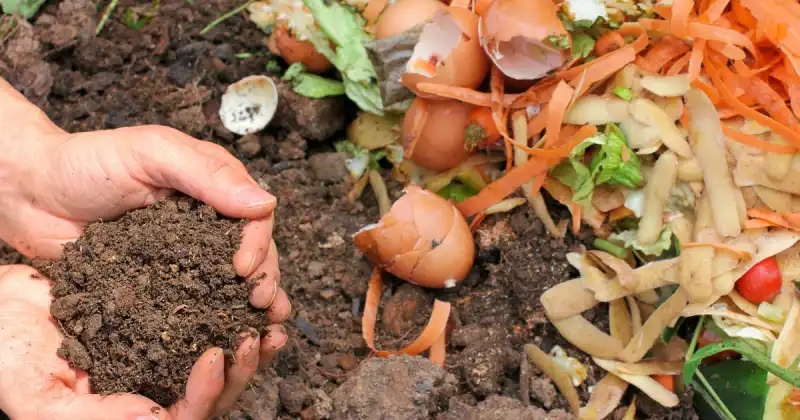
First, if starting a new garden, mix the compost into the existing few inches of soil before planting your first crop in spring. Secondly, laying the compost atop your soil for established gardens is perfectly fine. Remember, actively turning compost into your soil is best if your native soil is of poor quality or you are growing vegetables in a new space in which the soil has yet to be amended.
The choice is yours, of course, but I prefer to layer my compost in my existing garden beds to avoid disrupting the beneficial microorganisms within my garden soil. However, if I were to begin a new garden area, I would certainly use the full six inches of compost and mix vigorously with the compacted sandy-clay soil here in North Carolina. 2
Good, quality compost is more than just nutrient-dense plant food. Compost is a natural weed suppressant in your garden and helps your soil retain moisture, keeping the roots of your plants cool as temperatures heat up. When you layer or side-dress your plants with compost during these warmer times, you’ll provide a better environment with consistent soil temperatures your plants will enjoy.
When To Add Compost To A Traditional In-Ground Vegetable Garden
There are two best times to add compost to your vegetable garden: in spring, a few weeks before your first planting, and in late fall, after your last harvest. In spring, adding compost to your garden 4 to 6 weeks before your first planting helps prime the soil so your starts or seeds will have fantastic nutrients in which to use. Supplementing a fall compost revitalizes your soil while encouraging your garden’s beneficial ecosystem, like worms, to stick around to fertilize over winter.
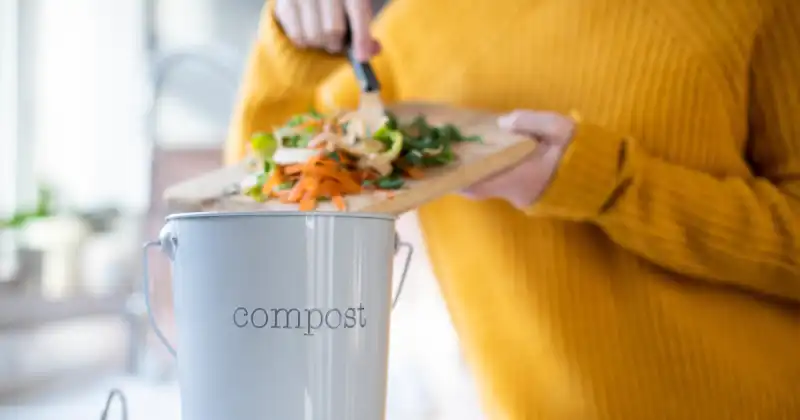
Remember, a garden is a beautiful place of rebirth and growth. Everything from the microorganisms in the soil to your flourishing plants is alive. Adding high-quality compost to the ground is essential in helping continue that life cycle and, in turn, rewarding you with delicious and abundant fruits and vegetables.
After removing any winter debris, adding a thick layer of compost to your garden after your region’s last average frost date is an excellent habit to adopt come spring. This new injection of organic matter into your garden beds helps improve the texture and fertility of the soil, which, in turn, supports a healthy vegetable crop.
Another great time to add compost to your garden is around October, after your last backyard harvest and when temperatures begin to cool for the coming winter months. Having a layer of quality compost sitting atop your garden beds for a few months over the coldest time of the year helps strengthen your soil’s overall health in preparation for an abundant spring.
Plus, as mentioned above, supplying compost before winter gives the worms and other beneficial soil organisms an excellent reason to stick around in your garden beds during winter. As a result, having these helpful life forms present in your garden in abundance is advantageous when planting your first crop of the season in spring. 3
Because compost is nitrogen-rich, adding it to your garden allows your plants to feed on this essential nutrient throughout the plant’s lifecycle.
When To Add Compost To Raised Beds
The best times to add compost to your raised garden beds are before the first planting in spring and again in late fall, after your last harvest. Because raised beds provide better drainage, consider supplementing your garden with 1 to 2 inches of compost with each successive planting during the year. As nutrients are washed away, it’s crucial to maintain an excellent nutrient balance within your soil with additional compost amendments.
Check Lowest Prices On Raised Garden Beds Today
Adding compost in spring and fall, you’ll improve your soil’s vitality and provide a layer of organic matter that benefits your garden’s microorganisms, fungi, and bacteria. And that is a win-win for you and your garden throughout every growing season.
When To Add Compost To Fruit Trees
When adding compost to fruit trees, apply 2 to 3 inches of high-quality compost every three months for optimal growth, health, and maintenance. Although you can do this throughout the year, the best time is spring when the plant’s flower buds first appear.
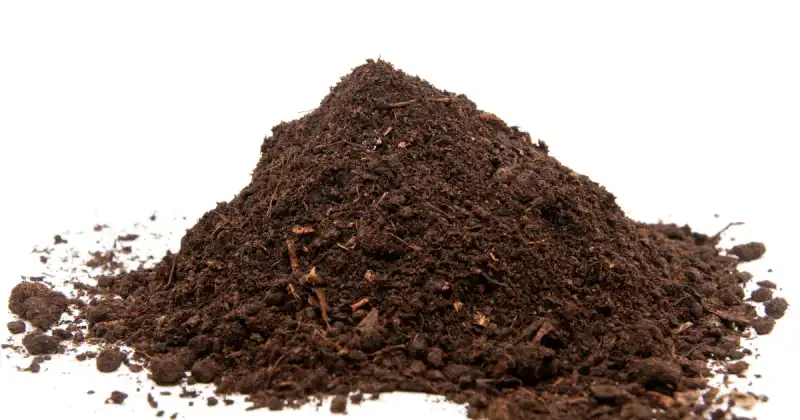
However, working compost into the existing soil is not advisable, unlike your garden beds. Fruit trees have fragile and shallow root systems that lay just under the soil surface, which you’ll want to preserve. Instead, treat your compost as mulch and layer it on your growing area.
Also, when it comes to fruit trees, a good practice is to add a layer of compost as soon as the leaves fall off later in the year. This extra nutrient boost later in the year helps keep your fruit trees happy and healthy over winter.
When To Add Compost To Container Pots
When adding compost to container pots, mix it thoroughly with the potting soil in an even 50/50 split. Then, with each successive planting throughout the growing season, add 1 to 2 inches of compost directly atop the soil. And just like traditional in-ground gardens and raised beds, spread the compost evenly over the entire top surface of your pot, no matter the size.
In contrast to other gardening methods, having a higher compost concentration in your container pots is best since the soil tends to dry out faster. The dryer the conditions, the more watering you’ll need to do. And with all this extra watering, you’ll be draining excess nutrients from the soil, meaning you’ll need to replenish them regularly.
If you’ve saved the soil in your pots from the previous year, consider applying 3 to 4 inches of compost atop in early spring. Then, allow this compost to sit untouched for about three weeks, and mix it into the existing growing medium before planting.
You’ll also want to ensure your leftover soil stays moist, whether in pots or garden beds. Because dry soil can happen just as frequently in the winter as in the summer, you’ll want to water your soil to help keep the microorganisms happy and active over winter. Yes, it may be strange to whip out the garden hose and water a bit during the coldest months of the year, but a little moisture can go a long way to improve the health of your garden, especially when the temperatures drop.Here’s a helpful video I found that shows precisely how much compost to use in your garden and how to apply it appropriately around your vegetable plants.
How Much Compost Should I Use In My Vegetable Garden?
While there is no fixed answer regarding how much compost to use for fertilizing vegetables, following a general rule of 1 cup of compost per 5 to 6 square feet is good practice for established vegetable beds. Additionally, when mixing compost in the soil, aim for a 4:1 ratio of soil to compost.
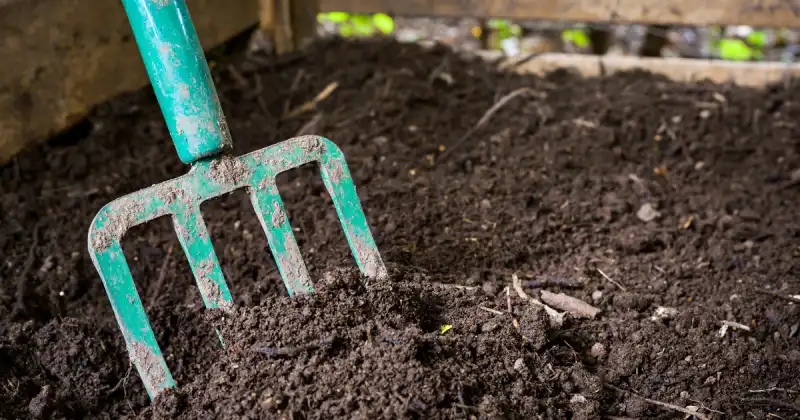
Always remember the quality of the soil you’re mixing with your compost. For example, if you start a new garden with poor soil structure, more compost is needed to amend your growing space and provide an inviting atmosphere for your plants. If this is the case for you, I recommend mixing 4 to 6 inches of compost into the native soil for new growing areas to ensure broad coverage for your plants and their roots.
On the other hand, and as mentioned above, an established garden bed with good soil fertility may only need 1 to 2 inches of compost. Add this layer every few months around heavy-feeding veggies, like brassicas, or before each new seasonal planting. 4
Excessive compost applications can result in excess moisture, making it difficult for your vegetable garden to drain appropriately. In addition, increased moisture can lead to fungal issues within your soil, among other ailments your plants may unnecessarily need to manage.
According to the University of Minnesota Extension, adding cover crops to your garden beds is an excellent secondary strategy for supplementing your garden’s soil health and providing extra nutrients to your crops.
Check Lowest Prices On Cover Crop Seed Mixes Here
Do You Add Compost Before Or After Planting?
Generally, adding 3 to 4 inches of compost within established garden beds is best 4 to 6 weeks before planting, although 2 to 3 weeks is also satisfactory. Layer this compost atop the existing soil or work the compost into the top several inches depending on the soil quality and if you have an established garden or just starting one.
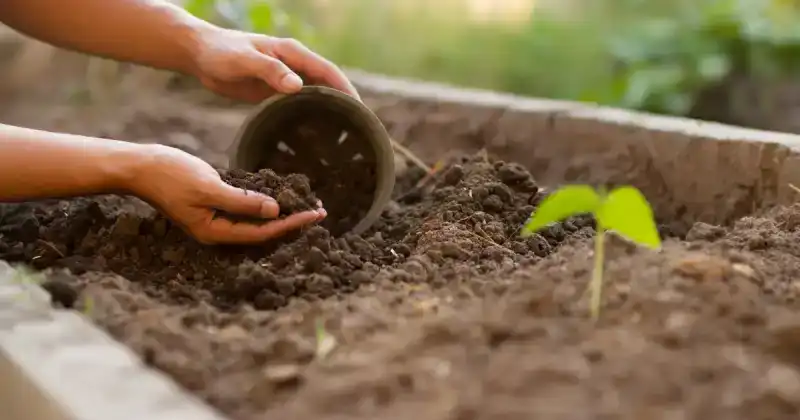
Continue adding compost to your budding garden as your plants grow each season. Additionally, consider side-dressing any vegetable or fruit plant, like heavy-feeding varieties like squash, tomatoes, and corn, with an extra handful of compost every 3 to 4 weeks to help them stay well-nourished. Even mature vegetable plants appreciate the extra nutrient boost compost brings when regularly applied. 5
Should I Add Compost To The Garden In Fall Or Spring?
Although adding compost to your garden anytime benefits your growing operations, adding it in early spring and late fall has many advantages. Incorporating compost in spring provides vital nutrients to your seeds or young starts while acting as a natural and effective weed suppressant. Applying compost before the first frost in the fall allows nutrients to break down over the winter and feed your soil’s ecosystem.
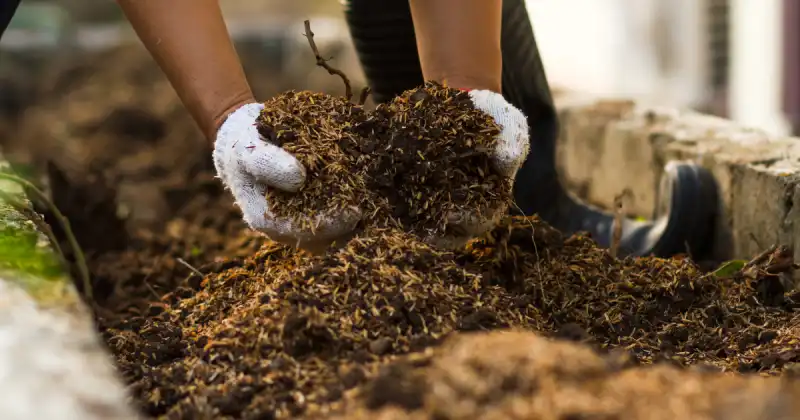
One of the best advantages of adding good-quality compost to your vegetable garden in spring and fall is that it saves money. As a grower, nothing is more disheartening than sown seeds that don’t sprout or young starts that do well for a week or two only to wilt and die for no apparent reason.
Providing adequate compost offers a more natural, healthy, and beneficial environment where your plants can thrive. And that makes for better, more abundant harvests while being much easier on your wallet.
As a final step, consider covering your compost by adding a layer of natural mulch, whether shredded leaves, woodchips, or straw. This extra layer of mulch helps protect the soil while locking in moisture into your garden soil. One of my favorite mulches to add is shredded leaves. They quickly break down in your garden bed and provide more nutrients to your budding plants and seedlings.
Is It Too Late To Add Compost To A Garden?
There is never a wrong time to spread additional compost in your vegetable garden. The most common time for gardeners is in early spring and late fall. Another popular time is when heavy-feeding vegetables must be side-dressed with compost to boost nutrient uptake to provide better yields.

If you are still looking for further information about when to add compost to your garden, check with your local extension office. Extension offices are staffed by university personnel and locally trained volunteers who coordinate and run specialized programs that provide science-backed horticulture information and knowledge. These programs can help you choose the best time to add compost to your garden based on your specific region, temperature, weather, and climate while guiding you through the process.
One of the most effective extension programs is the Master Gardener Program which is provided with a grant through the United States Department of Agriculture. You may discover a local program in your area by visiting the Extension Master Gardener website and selecting your state for the appropriate contact information.
Conclusion
Gardening is a great way to help improve the environment and strengthen your peace of mind regarding food security. So, to better care for and maintain your vegetable plants, provide your green friends with a balanced ecosystem that helps them feel right at home.
One of the easiest ways to do this is by adding a few inches of compost at different times throughout the year. Not only will you significantly improve soil quality, fertility, and structure, but you’ll also allow your garden to retain additional moisture. And knowing when to add that compost to your garden ensures your veggies consistently get the nutrients they need.
Apply 3 to 6 inches of mature compost, also called humus, to your garden about a month before your first planting in spring and reapply again in late fall, directly following your last traditional harvest. Remember, for heavy-feeding veggies like squash, tomatoes, peppers, broccoli, cabbage, and cauliflower, you may need to side-dress with an additional 1 to 2-inch layer every month throughout their lifecycle, so your plants may reward you with tasty yields.
Do you have a compost pile in your backyard? How often do you add compost in your vegetable garden? Be sure to let us know by dropping a line in the comments below!
SOURCES
- Wikipedia – Compost
- Oregon State University, Extension Service – How To Use Compost In Gardens And Landscapes
- Clemson University, Cooperative Extension Home & Garden Information Center – Soil Conditioning – Establishing A Successful Gardening Foundation
- United States Environmental Protection Agency p Composting At Home
- University Of Minnesota, Extension – How To Correct Problems Caused By Using Too Much Compost And Manure

